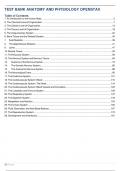Exam (elaborations)
TEST BANK ANATOMY AND PHYSIOLOGY OPENSTAX
- Course
- Institution
TEST BANK ANATOMY AND PHYSIOLOGY OPENSTAX Table of Contents 1. An Introduction to the Human Body ................................................................................................................. 2 2. The Chemical Level of Organization ..................................................
[Show more]



